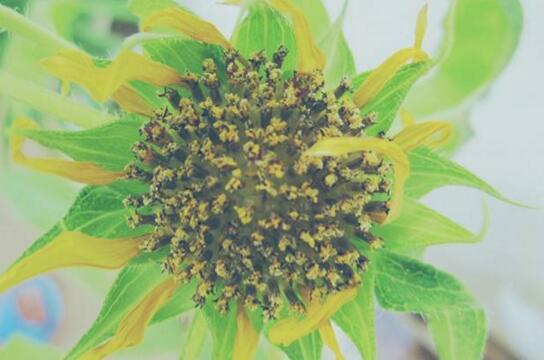How to do sunflower leaf wilt, pay attention to leaf blight / insufficient nutrients / planting methods
If you want to comment on the best plants, many people will think of sunflowers, but some people find that their sunflower leaves have withered, so some people don't know what to do. In fact, it can be saved if reasonable measures are taken. So what about sunflower leaves withering? Below, we will describe the respective reasons and treatment methods in detail.
What if the sunflower leaves wither?

The leaf wilting of sunflower is divided into two situations: the first is cotyledon wilting, which does not need to be worried, because cotyledon wilting is normal and detailed, and it will eventually be absorbed and withered, and the leaves growing between the two leaves do not need to be treated if they grow normally. The second situation is the growing leaf withering, at this time we need to know how to do sunflower leaf withering, need to analyze the reasons and then targeted to solve.
First, the planting method is normal
If we are sure that there is nothing wrong with our planting methods, then there are three main possibilities for leaf blight: leaf blight, overplanting, and insufficient nutrients. It is necessary to take corresponding measures to deal with these three situations.
1. Leaf blight
Symptoms: round-shaped spots appear on the leaves, initially 2-4 mm in diameter, grayish white in the middle, brown edges, and then gradually expanded to 5-20 mm, with brown spots on petioles and stems.
Cause: caused by bacteria, the bacteria will spread when the temperature is high.
Solution: what if the sunflower leaves wither as a result of this situation? In the initial stage, carbendazim was used to spray, usually pay attention to environmental hygiene, clean up the withered plants, and loosen the soil for other sunflowers.
2. Planting is too dense
Symptoms: short sunflowers have withered leaves, while other plants with plenty of light are normal.
Reason: planting is too dense.
The solution: what if the sunflower leaves withered after planting Miyamoto? To transplant withered sunflowers to other places, a more scientific way is to plant a sunflower in a flowerpot to avoid multiple sunflowers squeezed into one flowerpot.
3. Lack of nutrients
Symptoms: the edges of the leaves wither, the old leaves begin to fall off, and the new leaves can grow normally.
Reason: lack of nutrients.
Solution: insufficient nutrients may be caused by a variety of factors, such as too little watering, insufficient fertilization, insufficient light, etc., sunflowers should be placed in a place with plenty of light and water, and properly watered and fertilized. Usually once every five days.
Second, improper planting methods lead to leaf withering
If the way we plant sunflowers is incorrect, it will also cause its leaves to wither, what should we do about this situation? First of all, we need to understand the breeding methods and matters needing attention of sunflowers, only reasonable maintenance skills can avoid leaf withering.
Secondly, change our previous planting method, sunflowers will "turn the corner" after a period of time, but in this process, we should pay attention to: leaf yellowing and wilting are two different concepts, so we must distinguish them. What if the sunflower leaves turn yellow? The reasons should be found from the aspects of watering, fertilization and light.
Conclusion: the withering of the leaves of sunflowers is a headache, but no matter which situation there is a solution, what we need to do is to find out the cause and then solve the problem, for example, if there is not enough nutrients, we need to increase nutrients, and so on. Don't give up every sunflower easily.
Control of sunflower Sclerotinia sclerotiorum
Sunflower Sclerotinia sclerotiorum disease, also known as white rot disease, commonly known as rotten disk disease, this disease occurs in varying degrees every year in the main sunflower producing areas, the incidence rate is generally about 50%, and when serious, it can reach more than 80%. It has a great impact on the yield and quality of sunflowers. 1. Disease symptoms Sclerotinia sclerotiorum can occur in the whole growth period of sunflower, and the disease symptoms can be divided into the following two types. 1. Withered type. It can occur from the beginning of the seedling to before the disk is formed. In the seedling stage, the disease mainly occurred at the base of the stem, water-immersed disease spots were formed around the stem, white flocculent hyphae grew when it was wet, the disease part contracted and thinned after drying, black sclerotia formed in the stem, and the plant withered. In the adult stage, the disease mainly occurred at the base of the stem, showing a light brown wet spot, and then gradually expanded to the stem of the whole plant. In the later stage, the disease spot dried up and showed gray, the edge was brown, and the epidermis was ruptured. Due to the destruction of the transport tissue in the stem, the leaves began to turn yellow, wither and fall off gradually from the bottom up, resulting in the death of the whole plant. two。 Bad disk type. This kind of disease is the most serious after the flowering stage. When the disk is damaged, a water-immersed spot appears on the back of the disk, and the receptacle turns brown and softens. In rainy weather, the disease spot begins to expand rapidly, which can penetrate the disk, from the back of the black heart to the front, and grow a kind of white hyphae, which causes the disk to rot, so that the seeds cannot mature, and in serious cases, the seeds rot or the seeds fall off by themselves. Second, the cause of the disease is mainly caused by sclerotia germination and infection. The pathogen overwinters in soil, diseased tissue and seeds in sclerotia state, and can generally live in soil for 2 ~ 5 years. There are two ways of infection: one is that the sclerotia produces a kind of hyphae after germination, which invades directly when it comes into contact with the "host", and the disease occurs in the seedling and adult stages; second, the sclerotia can produce ascomycetes, and the ascospores are transmitted to the "host" through wind and rain or insects, and the rotten disk of sunflower is caused by the infection of ascomycetes. Generally, when the temperature is 20 ℃ and the relative humidity is 80%, it is the most suitable for sclerotia germination and the most serious period of disk disease. Especially in rainy years, the incidence is the highest in some low-lying plots with poor drainage, poor ventilation and light transmission and continuous cropping or stubble. If it is rainy and low temperature from July to August, the incidence rate is the highest. Third, prevention and control measures 1. Remove the diseased plant. When the diseased plant is found, it should be pulled out and destroyed immediately to prevent it from spreading. two。 Chemical control. (1) spraying the lower part of the plant and the back of the disk once or twice before budding or in full bloom; (2) spraying 1000 times of 50% topazine wettable powder once or twice before budding or in full bloom; (3) spraying 1000 times of 50% Sukeling at seedling stage or flowering stage, the control effect can reach more than 80%. (4) according to the occurrence law of sunflower Sclerotinia sclerotiorum, when the temperature reaches 18 ℃ ~ 20 ℃, the water content of topsoil is more than 11%, and the ascus begins to be unearthed, it is the best time to spread pesticide on the ground, 70% pentachloronitrobenzene 30kg ~ 45kg per hectare, humidified fine soil 150kg ~ 225kg, mixed evenly and sprinkled on the sunflower field. It can inhibit the germination of sclerotia and kill the young bud tube that has just germinated, the inhibition rate is generally 91.3%, and the control effect is more than 78.5%.
Scientific control of Sclerotinia sclerotiorum in sunflower
Sunflower (Latin: Helianthus annuus), belonging to the sunflower family, is an annual plant with a height of 1 to 3.5 meters. Stem erect, rounded and angular, hard white hirsute. Leaf blade usually broadly ovate, apex acute or acuminate, with 3 basal veins, margin coarsely serrate, both surfaces rough, hairy, long stalked. Inflorescences capitate, 10-30 cm in diam., solitary at stem tip or branch tip.
Involucral bracts multilayered, leafy, imbricate, hirsute, summer flowering, inflorescence margin with neutral yellow ligulate flowers, not sturdy. The middle of the inflorescence is bisexual tubular flowers, brown or purple, can bear fruit. Rectangular ovoid achene, pericarp lignified, gray or black, called sunflower seed.
Native to South America, the domesticated species was brought to Europe from North America by the Spaniards in 1510 and was originally used as an ornamental. At the end of the 19th century, it was introduced back to North America from Russia. It is cultivated in China. Sunflower seeds called sunflower seeds, often fried as a snack to eat, delicious, can also extract sunflower seed oil for consumption, oil dregs can be used as feed.
Sunflower Sclerotinia sclerotiorum disease, also known as white rot disease, commonly known as rotten disk disease, this disease occurs in varying degrees every year in the main sunflower producing areas, the incidence rate is generally about 50%, and when serious, it can reach more than 80%. It has a great impact on the yield and quality of sunflowers. 1. Disease symptoms Sclerotinia sclerotiorum can occur in the whole growth period of sunflower, and the disease symptoms can be divided into the following two types. 1. Withered type. It can occur from the beginning of the seedling to before the disk is formed. In the seedling stage, the disease mainly occurred at the base of the stem, water-immersed disease spots were formed around the stem, white flocculent hyphae grew when it was wet, the disease part contracted and thinned after drying, black sclerotia formed in the stem, and the plant withered. In the adult stage, the disease mainly occurred at the base of the stem, showing a light brown wet spot, and then gradually expanded to the stem of the whole plant. In the later stage, the disease spot dried up and showed gray, the edge was brown, and the epidermis was ruptured. Due to the destruction of the transport tissue in the stem, the leaves began to turn yellow, wither and fall off gradually from the bottom up, resulting in the death of the whole plant. two。 Bad disk type. This kind of disease is the most serious after the flowering stage. When the disk is damaged, a water-immersed spot appears on the back of the disk, and the receptacle turns brown and softens. In rainy weather, the disease spot begins to expand rapidly, which can penetrate the disk, from the back of the black heart to the front, and grow a kind of white hyphae, which causes the disk to rot, so that the seeds cannot mature, and in serious cases, the seeds rot or the seeds fall off by themselves. Second, the cause of the disease is mainly caused by sclerotia germination and infection. The pathogen overwinters in soil, diseased tissue and seeds in sclerotia state, and can generally live in soil for 2 ~ 5 years. There are two ways of infection: one is that the sclerotia produces a kind of hyphae after germination, which invades directly when it comes into contact with the "host", and the disease occurs in the seedling and adult stages; second, the sclerotia can produce ascomycetes, and the ascospores are transmitted to the "host" through wind and rain or insects, and the rotten disk of sunflower is caused by the infection of ascomycetes. Generally, when the temperature is 20 ℃ and the relative humidity is 80%, it is the most suitable for sclerotia germination and the most serious period of disk disease. Especially in rainy years, the incidence is the highest in some low-lying plots with poor drainage, poor ventilation and light transmission and continuous cropping or stubble. If it is rainy and low temperature from July to August, the incidence rate is the highest. Third, prevention and control measures 1. Remove the diseased plant. When the diseased plant is found, it should be pulled out and destroyed immediately to prevent it from spreading. two。 Chemical control. (1) spraying the lower part of the plant and the back of the disk once or twice before budding or in full bloom; (2) spraying 1000 times of 50% topazine wettable powder once or twice before budding or in full bloom; (3) spraying 1000 times of 50% Sukeling at seedling stage or flowering stage, the control effect can reach more than 80%. (4) according to the occurrence law of sunflower Sclerotinia sclerotiorum, when the temperature reaches 18 ℃ ~ 20 ℃, the water content of topsoil is more than 11%, and the ascus begins to be unearthed, it is the best time to spread pesticide on the ground, 70% pentachloronitrobenzene 30kg ~ 45kg per hectare, humidified fine soil 150kg ~ 225kg, mixed evenly and sprinkled on the sunflower field. It can inhibit the germination of sclerotia and kill the young bud tube that has just germinated, the inhibition rate is generally 91.3%, and the control effect is more than 78.5%.
- Prev

When does the orchid bloom and how to prolong the flowering period / barefoot flowering for 100 days?
Crane orchid, a very strange flower-shaped plant, seen from afar, looks like a crane that wants to spread its wings. The picture is really beautiful. Nowadays, the orchid has become a noble flower and enjoys a good reputation in the world. When will the orchid blossom? The length of flowering time will directly affect the ornamental.
- Next

How to fertilize sunflower, sunflower fertilization time / fertilizer selection is very important.
In order to make the sunflower grow healthily, in addition to the correct cultivation method of sunflower, fertilization is essential, which should determine the quality of flowers, the life span of sunflower and so on. So how to apply fertilizer is the best? Today, let's learn more about the fertilization time of sunflowers.
Related
- Fuxing push coffee new agricultural production and marketing class: lack of small-scale processing plants
- Jujube rice field leisure farm deep ploughing Yilan for five years to create a space for organic food and play
- Nongyu Farm-A trial of organic papaya for brave women with advanced technology
- Four points for attention in the prevention and control of diseases and insect pests of edible fungi
- How to add nutrient solution to Edible Fungi
- Is there any good way to control edible fungus mites?
- Open Inoculation Technology of Edible Fungi
- Is there any clever way to use fertilizer for edible fungus in winter?
- What agents are used to kill the pathogens of edible fungi in the mushroom shed?
- Rapid drying of Edible Fungi

